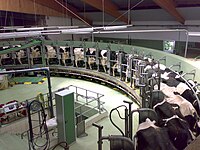
Photo from wikipedia
Foodborne pathogens have acquired the ability to produce biofilms to survive in hostile environments. This study evaluated biofilm formation, antimicrobial resistance (AMR), and heavy metal tolerance of bacteria isolated from… Click to show full abstract
Foodborne pathogens have acquired the ability to produce biofilms to survive in hostile environments. This study evaluated biofilm formation, antimicrobial resistance (AMR), and heavy metal tolerance of bacteria isolated from dairy and non-dairy food products. We aseptically collected and processed 200 dairy and non-dairy food specimens in peptone broth, incubated them overnight at 37 °C, and sub-cultured them on various culture media. Bacterial growth was identified with biochemical tests and API 20E and 20NE strips. The AMR of the isolates was observed against different antibacterial drug classes. Biofilm formation was detected with the crystal violet tube method. Heavy metal salts were used at concentrations of 250–1500 µg/100 mL to observe heavy metal tolerance. We isolated 180 (50.4%) bacteria from dairy and 177 (49.6%) from non-dairy food samples. The average colony-forming unit (CFU) count for dairy and non-dairy samples was 2.9 ± 0.9 log CFU/mL and 5.1 ± 0.3 log CFU/mL, respectively. Corynebacterium kutscheri (n = 74), lactobacilli (n = 73), and Staphylococcus aureus (n = 56) were the predominant Gram-positive and Shigella (n = 10) the predominant Gram-negative bacteria isolated. The correlation between biofilm formation and AMR was significant (p < 0.05) for most cephalosporins, aminoglycosides, and fluoroquinolones. Heavy metal tolerance tended to be higher in biofilm producers at different metal concentrations. The pathogens isolated from dairy and non-dairy food showed a high burden of AMR, high propensity for biofilm formation, and heavy metal tolerance, and pose an imminent threat to public health.
Journal Title: Foods
Year Published: 2022
Link to full text (if available)
Share on Social Media: Sign Up to like & get
recommendations!